Alex Watts's Blog, page 6
May 29, 2013
Why Michael Pollan Is Wrong About Sending Back Steaks In Restaurants

I like American journalist and current media
darling Michael Pollan, and the simple approach to food he advocates. In this era
of wall-to-wall cooking shows, where former supermodels can do a couple of
years at catering school and emerge as celebrity chefs teaching the nation to
bake while older, far more experienced cooks are left on the shelf, it’s a breath
of fresh air.
A well-researched, beautifully-written breath of
fresh air that may motivate even the laziest, crisp-munching foodie to turn off
the telly and actually cook a meal themselves, rather than wondering who’s
going to be knocked out next, or tweeting about how James Martin looks like an
owl in a Noel Gallagher wig, and can’t read the autocue (alright, I was guilty
of that one).
I love Pollan’s advice about how we should all eat
out less and cook for ourselves. I like his proselytising about how we should
be less greedy, and eat more plants. I like his simple guidelines for eating - “It’s
not food if it arrived through the window of your car”. I like the tales of his
cookery experiments in his new book Cooked - a book being feted on both sides
of the Atlantic as some sort of born again Bible in this age of unnecessarily-fussy
recipes and long-run-out-of-ideas food programmes about building giant mince
pies for bemused Greggs-goers in the centre of Birmingham.
But there is one thing he is very wrong about -
and that is his views on ordering well done steaks in restaurants. On first
sight, Pollan seems to be on to something. He urges us to ensure the quality of
the meat - provided you like your steak well done or medium-well, and not a
bloody hunk of seared flesh like most people - by ordering it rare, and then,
and this is the cunning bit, sending it back to be cooked more.
That way, he says, you can guarantee the quality,
and perhaps in these horsian days, the provenance of the meat. The logic being
that devious chefs will try to pass off the nastiest pieces by serving it to
the idiots who ask for their steaks well done, or ‘ruined’ in chefs’ cant.
There is truth in this. I’ve worked in restaurants
where gnarly, green-tinged, everyone-has-a-sniff, about-to-go-in-staff-food steaks
are reserved for customers who favour cremated meat. And it’s not just because
it’s easier to get away with - it’s disgust. You see, chefs hate overcooking meat.
“Fucking plebs!” they’ll be ranting as three orders for well done come in on
table one. There is no chance to showcase their semi-mythical cooking talents
if the meat is grey, and dry as Gandhi’s sandal.
But there is something chefs hate much more than
having to ruin a lovely piece of meat, and that’s the humiliation, dented pride,
and battered ego of having food sent back to the kitchen. It causes uproar. The
restaurant is afraid to relay the message to the head chef, and the lowly
commis in the brigade will make sideways glances and snigger. “Big bollocks has
fucked up!” they’ll be thinking.
As revenge, I’ve seen chefs take a beautiful piece
of returned steak and throw it in the deep-fat fryer until it’s well done, such
is the disdain for people who hand back their beloved food. And I’ve heard of,
and seen, far worse incidents.
On one occasion, I was working in a gastropub in
Cornwall when an eye fillet came back. The chef ranted and slammed plates on
the pass, and ran around the kitchen for a few minutes finding fault with
everything, and quickly trying to pass off his perceived negligence by bullying
the lower ranks while the steak sat there on the pass, oozing blood and greyish
gobs of juice.
He then picked up the steak, pulled down his trousers,
and wiped his arse with it. I apologise if you’re eating at this point, but I’m
using it as an example of what can happen when you hand food back to a kitchen. And it’s not just steaks, of course. Troublesome
customers may be munching through their just-returned salad oblivious to the
saliva, or worse, in the chef’s special sauce, or the bogey hidden in the
leaves, or the urine in the mussels etc etc.
I learned a lot in the time I spent cooking in
restaurants, not least that I had a huge amount to learn, and that being able
to throw a decent dinner party, or prepare a deep, deep pudding for Egg and Toad in a TV studio, is absolutely no use in preparing you for the rigours of a
professional kitchen. All bright-eyed amateurs discover the same - that they
are about as useful to the tattooed bunch of leather-fingered limpet berries
around them as a snooze button on a smoke alarm.
But one thing I did learn is never hand food back.
It’s just not worth it. The thought of what might be in there, what your soup
might have been doctored with, will more than take away any enjoyment of the
meal. Whenever a waiter asks how my meal is, I always mumble some platitude
even if it’s fucking awful. And if it’s great, I let them know that too. But I never
send food back to a kitchen. Never!
Pollan is right about the ability to see the
quality of a steak if it’s rare, and how overcooking covers up a multitude of
sins. But the trust he puts in the deranged characters you often find in
kitchens is a touch naive. I hope his steaks, or those of his readers, never
come back matted with sweat and other horrors that weren’t there on first
arrival, but returning food to guarantee its quality is ludicrous advice.
:: My new, bestselling food book Down And Out In South East Asia is an adventure story, spiked with a heavy dose of backpacker noir, through the eateries, street food stalls, and hazy bars of Cambodia, Thailand, and Vietnam.
Published on May 29, 2013 07:20
May 28, 2013
Recipe Errors And Other Local Newspaper Howlers
My first newspaper job was writing a recipe column
for a weekly paper. I used to make up the 100-word introductory flannel,
talking about stews that dated back to Chaucer, the aphrodisiacal qualities of
nettle soup, and dishes named after made-up minstrels.
For Newbury Pork Chops, I’d written: “This
traditional country recipe dates back to a time when only the fattest and most
succulent pork would be used. Newbury pigs were taken through the woods to
sniff out truffles, and some chefs would add one or two to enrich the
flavour...”
I had no idea whether there were even any truffles
in Newbury. About the only thing I knew about the place was it had a
racecourse. But it all went horribly wrong when I went travelling to South
America. I’d written up the recipes beforehand, and each week my mother sent
one in.
But I got held up in Colombia and ran out of
recipes. My mother covered for me for a while, dutifully copying out recipes
from cookbooks, until she did one for chocolate cake and the editor got calls
from readers saying their cakes had come out “as flat as kipper’s piss”.
It
turned out she had forgotten to put the eggs in.
But as mistakes go, it was a minor one compared with
this one in a local newspaper in the US - which goes to show even the most
tried-and-tested recipes should never be set in stone...

But then at least the howler wasn’t on the front
page...
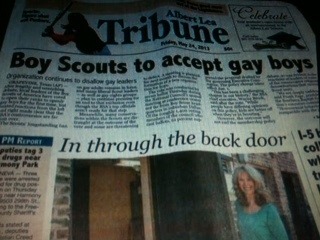
Published on May 28, 2013 07:47
Cambodian Food: Eating Duck Embryos And Cow Guts
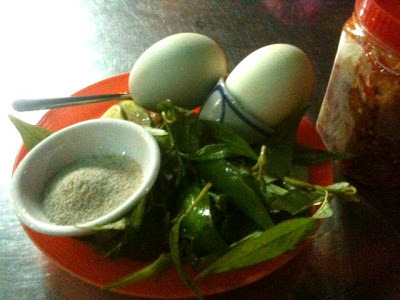
I met a woman in the sea who works as a marketing
manager for Hyundai and eats for a living. By that I mean she takes rich Asian
clients around the culinary hotspots of Phnom Penh to give them a good feed and
persuade them to buy land-gouging equipment.
“I know all the best places - it’s my job,” Alin
said, before quickly spotting a shadow in the water and asking me if there were
sharks in Cambodia .
She offered to show me a tiny, family-run joint
that serves the best Khmer chicken curry in the capital, and another cheap place
that only sells duck soup, and the best street food stall for fertilised duck
eggs, and a restaurant that specialises in offal with prahok sauce , and a
number of other places I’ve forgotten about because by now I was looking for
sharks too.
I met her a week later after catching a bus from
Sihanoukville to Phnom Penh. She picked me up on her moped outside the Central
Market and we headed off to a smart area of BKK1 to eat cow guts. It was at a
type of restaurant known in Khmer as pu ko tuk prahok (cow stomach with prahok
sauce).
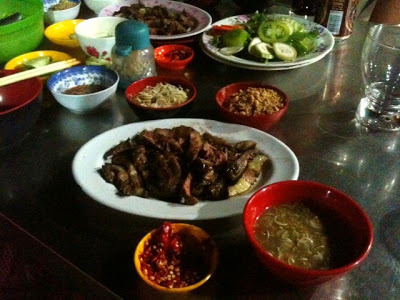
It was Saturday night and the place was rammed.
There were people sat around on mopeds watching every chopstick, and waiting
for tables to clear, and still more people kept arriving. We sat down on a
wooden bench next to a cook barbecuing steak, and joined the queue. Not that
there was a queue, or line, if you speak Ameringlish - people dived in if you weren’t quick enough.

Ten minutes later we were perched on two seats
opposite an old Cambodian man who was merrily stuffing himself with intestines
and cans of ABC - a hideously-strong local stout. He smiled as we sat down and
Alin ordered away.
The first dish came in the time it took the waiter
to walk 20 steps from the wooden boards where the cooks were chopping with blinding
speed. It was grilled sirloin steak, served medium-rare and cut into thick
slices. It came with bowls of grey prahok sauce (tuk prahok), lemon grass, red chillies,
ground peanuts, lime quarters, and a plate of vegetables that she called a
“Cambodian salad” - slices of green tomatoes, green bananas, culantro, and raw
aubergines.
Then the star dish arrived - cubes of liver, sliced
intestines, and strips of tripe, all simmered in beef stock. It was wonderful.
We sat there dipping the offal into the cheesy, fermented fish sauce, and then
the owner came over to chat to the only white face in there.
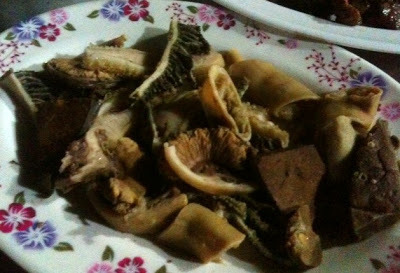
He was a rich Cambodian who lived in New Zealand,
and his parents had set up the restaurant 20 years ago when the area was a dark
ghetto and not the gentrified, boutique-filled strip it is today. He looked on
proudly as more Cambodians arrived, waiting for tables to clear.
The next stop was a bustling street food stall
outside Orussey Market, near the Olympic Stadium, that Alin said sold the best fertilised
duck eggs (balut) in Phnom Penh. They were 18-days-old - the best age, she said. Not
too ancient to develop too bony a crunch, and not too young to be beakless.
The eggs had been steamed over a charcoal burner,
and were piping hot. We held them with paper napkins as we cracked open the
shells and looked at the strange life form inside. I’d tried them before, but
hadn’t looked too closely. I’d just shut my eyes, whacked the thing in my
mouth, and swallowed as quickly as I could, trying to banish the thought of
dark feathers tickling my tonsils, and beak crunching between my teeth. Then I
downed a tequila.
This time I was determined to conquer my
squeamishness. I sipped the brown liquor from the shell as instructed. It had a
curious taste similar to duck stock and was delicious once you allowed yourself
to forget about the alien beneath.
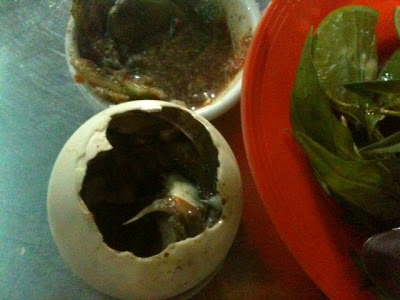
Then I spooned out a chunk of embryo head, crowned
with feathers, and dipped it in garlic and chilli pickle (again as instructed)
- followed by a couple of sprigs of a bitter-tasting herb that Alin called chi
bong tia korne (fertilised duck egg herb) - and then another morsel of
yellowy-brown foetus.
The unborn chick had a flavour that I found
difficult to describe. It tasted a little like scrambled egg and had a soufflé-like
texture. Then I crunched on the beak and tried to hide the thought of what I
was eating from the rest of my mind.
As soon as I’d finished, Alin pointed to the
second egg, and I got to work on that one too. It was far from unpleasant -
reflected in the way young couples on surrounding tables were enthusiastically
studying each flavour and nodding appreciately.
But it made me realise just how different people’s
tastes vary from East to West. There was no way they’d take off as a street
food snack in London, however good they tasted. I’d seen the same look on Khmer
people’s faces when I’d given them mayonnaise .
:: My new, bestselling food book Down And Out In South East Asia is an adventure story, spiked with a heavy dose of backpacker noir, through the eateries, street food stalls, and hazy bars of Cambodia, Thailand, and Vietnam.
Published on May 28, 2013 06:44
May 24, 2013
Reviews Of Down And Out In South East Asia
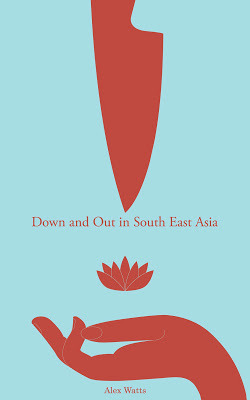
Well, my new book Down And Out In South East Asia
has been out for a week or so now, and I’ve been very pleased - not to say
hugely relieved - with the reviews so far. Even from people I didn’t pay to write them (I’m
joking of course - my ‘marketing budget’ wouldn’t keep Jay Rayner in L’Oreal
shampoo for a week).
It’s the sequel to my bestselling food book Down And Out In Padstow And London , and tells the story of how failed chef and hack
Lennie Nash sets off to eat his way through SE Asia, with a half-baked plan to
buy a restaurant.
Along the way, he encounters a host of weird characters from frazzled bar
owners to Walter Mitty CIA agents to seedy sexpats to ice zombies four years
over on their visa. The book is an adventure story, spiked with a heavy dose of
backpacker noir, through the eateries, street food stalls, and hazy bars of
Cambodia, Thailand, and Vietnam.
There is an edited extract on Khmer 440 if you
fancy a read - where Nash launches a doner kebab business in Cambodia with
mixed results...
But anyway, here are the reviews I’ve had so
far...
Chris How: “I loved this book, and it made me
slightly ashamed of my own rather pedestrian gustatory experiences in Asia. This
is no hippie-dippie 'how I found myself in Asia' travelogue: Alex shows us the
darker, grittier side of life in another world, generously spiced with
well-researched helpings of real Vietnamese and Cambodian cooking.
“I would recommend this book to anyone with an interest in Asian food or
travel.”
Christian Williams: “Down and Out In South East
Asia is a great read from start to finish. It takes you from the grim reality
of 'The Hill' with its truly bizarre characters to the food markets of Vietnam
and Cambodia, where some of the best eating is to be found.
“Finishing the book made me look into a holiday in
South East Asia and I might just do it, but I will be giving 'The Hill' a wide
berth.”
Claire: “In Down and Out, would-be chef Lennie
navigates a precarious path in his quest to set up his own restaurant in a
place in the sun.
“Whilst this travelogue follows the usual
backpacker circuit of Thailand, Vietnam and Cambodia (the standard destinations
for those 'doing Asia'), Down and Out stands out in that it takes you well off
of the culinary beaten track and the staple dishes that feature in your Lonely
Planet guide food section.
“Your taste buds tingle from the exotic flavours
and street foods that Lennie seeks out with sweaty determination, tempting even
the most seasoned traveller to want return to take a braver step in their
digestive exploration of this part of the world.
“But as always, the longer you stay, the more you see, and Lennie has his
mettle tested in this seemingly exotic idyll by its less attractive underbelly
made up of a strange collection of misfits who have long since lost their grasp
of reality and in some cases, their moral compass, if they ever had one.”
Chippy: “Thankfully it wasn't quite as bleak as
'London and Padstow' (which isn't to say I didn't love that one too). I'm
looking forward to Lennie's next adventure.”
Published on May 24, 2013 12:10
May 17, 2013
Restaurants And The Dangers Of Using Google Translate
I just heard a rather charming tale about a group
of British pensioners who have just returned from a week’s holiday in northern
Italy.
One night they went to eat at a small, family-run
restaurant in the hills outside Florence. The owner could speak no English, but
proudly translated his menu to them using Google Translate.
But it seems he got a trifle carried away after
they’d left, and sent them this message to thank them for their custom...
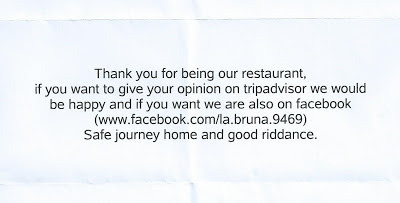
:: My new, bestselling food book Down And Out In South East Asia is an adventure story, spiked with a heavy dose of backpacker
noir, through the eateries, street food stalls, and hazy bars of Cambodia,
Thailand, and Vietnam.
Published on May 17, 2013 10:22
May 2, 2013
Down And Out In South East Asia

Well it’s finally
done. The book I mean. If you enjoyed my bestselling food book Down And Out In
Padstow And London, about cooking in restaurants in the UK and the larger-than-life
characters that inhabit them, then hopefully you’ll like the sequel Down And Out In South East Asia .
It sees the return of
failed chef and hack Lennie Nash - this time setting off to eat his way through
SE Asia, with a half-baked plan to buy a restaurant.
Along the way, Lennie encounters a host of weird
characters from frazzled bar owners to Walter Mitty CIA agents to seedy sexpats
to ice zombies four years over on their visa.
The book is an
adventure story, spiked with a heavy dose of backpacker noir, through the
eateries, street food stalls, and hazy bars of Cambodia, Thailand, and Vietnam.
Anyway, I’d be
delighted if you read it. It’s only out as a Kindle book to start with, and
costs £1.99 - about the price of half a lager in the UK now, I’m told. Go on,
you’ll have a lovely warm glow inside knowing you’ve kept me in noodles for
another day... CLICK HERE
Published on May 02, 2013 05:03
March 27, 2013
All The Rubbish In The Cambodian Sea
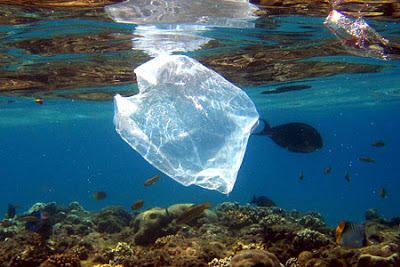
A plastic sheet, a bottle top, a sheet of rubber,
a sponge,
A plastic spoon, a thousand straws, scattered
across the sand,
A lady’s shoe, a toddler’s shoe - who lost them
who would know?
A toothbrush caked in sewer sludge, back from sea
to land.
Another wave, this time brings, a bottle of green
tea,
No preservatives, no colouring, and yet won’t rot
away.
Another sheet, another sponge, wrapped in rope and
weed,
Another squid lure smiling, its hook long perished
away.
More yellow rope, more neon string, a coconut
gleams gold,
Another lighter, a bicycle pedal, grey beneath the
sand.
A sheared off lid of gasoline, a lid of Nescafe,
A bottle this time of herbal tea, made in Vietnam.
A lump of wood from a shipwrecked ship, painted toothpaste
blue,
A plastic float, another shoe - this time 42.
A pineapple top, more lures and line, how many
squid they catch!
A packet of durian crackers, high in iron and
crap.
A measuring jug half-filled with sand, another can
from Vietnam...
A brother and sister no more than 12, still in
their school clothes,
Wash out a bag and walk the beach, collecting
bottles and cans.
But they leave the lures, the wooden planks, the
lighters, shoes and rope,
The straws, the string, the plastic spoons, the
countless plastic cups,
The fishing line, the endless bags - there’s no
money in any of those!
Oh what a shame that plastic, isn’t worth its
weight in gold...
Published on March 27, 2013 05:12
February 14, 2013
Chef 'Tried To Kill 10 Kitchen Staff By Poisoning Staff Food'
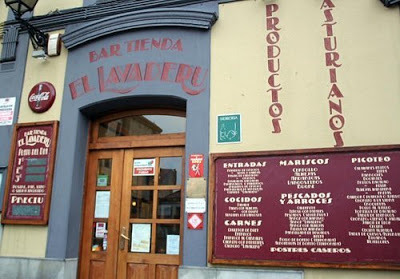
A Spanish chef has been charged with trying to poison
10 of his fellow cooks over a six-year period by secretly adding toxic drugs to
staff food.
The unnamed 55-year-old assistant cook, who worked
at El Lavaderu bar and restaurant in the coastal city of Gijon in northern
Spain for seven years, is accused of 14 counts of attempted murder and is being
held in custody awaiting trial.
His kitchen colleagues phoned police in October
last year when they became suspicious after repeatedly falling ill. The only
people at the cider house not to share symptoms were the suspect and his
girlfriend, who also worked there.
Officers tested plates used for staff meals and found
traces of calcium cyanamide, a potent chemical used to treat chronic alcoholism,
the Daily Telegraph reported. It causes sickness and palpitations if mixed with
alcohol and can have fatal results if taken long-term.
They are also re-examining the death of the former
head chef who died from a heart attack in May 2011, and may exhume his body to
see if there are traces of calcium cyanamide.
The previous owner also suffered a heart attack
before selling the premises last year, and his wife suffered mysterious bouts
of ill-heath. Both recovered after leaving the business.
Another chef has been to hospital three times over
the last year and several other kitchen workers have frequently called in sick.
Police said they suspected "rancour" was
the motive after reports there had been frequent arguments in the kitchen.
The current owner, Florentino Pérez, told Europa
Press he also suffered from the poisonings but never imagined the suspect was responsible.
"People
loved him," he said, adding that the chef had been involved in a
number of charities in the city. He confirmed the suspect, who suffered from
alcoholism, was fired a month before he was arrested, but said that was due to
a slump in business.
Published on February 14, 2013 23:50
February 12, 2013
Gordon Ramsay Caught Lying About His Three Michelin Stars

Gordon Ramsay has been caught telling pork pies
again after announcing he is to close his flagship restaurant for a revamp in a
bid to keep his three Michelin stars.
The celebrity chef told American food magazine Bon
Appétit he’d had a conference call with bosses of the French tyre guide on
Friday to tell them that Restaurant Gordon Ramsay in Chelsea, London, would be
shut for two months for “an amazing new refurb”.
He said: “I think every five years at that level,
to reposition yourself is important. We’ve got three Michelin stars, the
longest time a British restaurant has had three Michelin stars. So every five
years, it needs to be moved up.
“Because you get criticised easily. ‘Well, it’s
not worth three stars anymore, he’s cashing in, he’s never there’ - all those
kinds of things. So you gotta silence those critics by constantly reinventing.”
Reinventing? Perhaps it’s the truth the
notoriously slippery chef is talking about in the taped interview. Because his
restaurant in Royal Hospital Road has not held three stars the longest in
Britain. Far from it. That honour is held by The Waterside Inn , in Bray,
Berkshire, which has had three gongs since 1985 - a piffling 16 years before
Ramsay got his.
Ramsay, 45, is right about one thing. He has had a
lot of criticism for not being behind the stoves of his restaurants and for
spreading himself too thin in his pursuit for world domination. Not least from some
of his former lieutenants who emerged blinking from the shadow of his large
posterior to open restaurants in their own name, without having the constant
gall of Ramsay taking credit for their hard work while lounging around in the
California sunshine.
But what has that got to do with a new paintjob
and a bit of interior design? Is he so sick of the decor in his 45-seater eatery,
if he can still remember where it is, that he can’t stand being there? Will the
wonderful revamp mean he will spend more time sweating in his flagship kitchen,
run by head chef Clare Smyth for the past six years, rather than parading himself
in front of American TV audiences like a painted horse and playing MonkeyTennis ? Unlikely if his past performances are anything to go by.
And how does a splash of sage green “silence
critics” who accuse him of cashing in? Ramsay - who has just opened two new eateries
in Las Vegas, Gordon Ramsay Pub & Grill and Gordon Ramsay BurGR (GR, geddit?)
and is to launch a London restaurant with David Beckham - has been cashing in and
embellishing the past ever since he was in short trousers.
First, with his lie about having played first-team
football for Glasgow Rangers, before his career was cut short by an injury, creating
the myth of the tragically injured football star who re-invented himself as a chef. And secondly with his TV fame and the dark PR arts he uses to keep his name in (and
out) of the newspapers.
As he goes on to say in the interview: “It
(cooking) is a tough business. A very tough, demanding business. And it’s
slightly Machiavellian in that you need to be strong, especially at this level.”
Slightly Machiavellian? I think Niccolo would have been proud. Perhaps he should say longest in the world in the next US interview, and
say he was soccer captain for Manchester United. After all, it’s important to keep
constantly reinventing.
:: Gordon Ramsay: A Cut Above The Rest?
:: From Ramsay To Rourke
:: Go Easy On The Ham Ramsay!
:: The Night The Roux Brothers Had Bread Rolls Hurled At Them
:: What's Next For Gordon Ramsay? Monkey Tennis?
Published on February 12, 2013 11:16
February 3, 2013
Sushi Chef Faces 67 Years In Jail For Selling Endangered Whale Meat
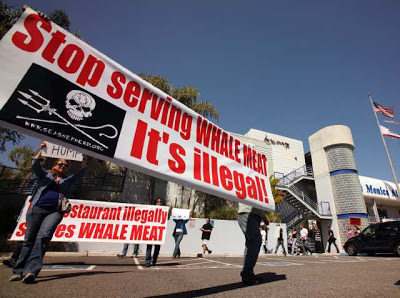
A head chef faces up to 67 years in jail after he was allegedly caught in an undercover sting selling illegal whale meat at a trendy sushi
restaurant in California.
Kiyoshiro Yamamoto, 48, from Culver City, is accused of nine
counts of conspiracy to import and sell endangered Sei whale meat from 2007 to
2010, a violation of the Marine Mammal Protection Act.
Another chef, Susumu
Ueda, 39, from Lawndale, and the restaurant’s parent company, Typhoon
Restaurant Inc, have also been charged. Ueda faces up to 10 years' jail, and Typhoon a fine of up to £800,000.
The now-closed Hump restaurant was allegedly filmed by the
team behind Oscar-winning documentary The Cove, which features covert scenes of
the barbaric annual dolphin hunt in Japan (see trailer below).
One of the activists had been tipped off by
friends in the music industry that whale meat was being served at the £200 a
head restaurant in Santa Monica. They went along there with hidden cameras
during the Academy Awards ceremony in 2010, and say they were given thick, pink
slices of whale on the omakase menu, where chefs choose a selection of dishes
for customers to try.
In the footage, the waitress can be heard calling
the meat “whale”. It was also referred to by its Japanese name, kujira. The
pair put the £40 dish in a bag and sent it off for DNA analysis to the Marine
Mammal Institute at Oregon State University.
Scientists confirmed it was Sei whale, which are
endangered but hunted in the North Pacific under a controversial Japanese
programme that allows the killing of up to 1,000 whales a year under the guise
of scientific research.
Police then carried out their own undercover
operation and broke up the alleged smuggling operation. According to court
papers, staff said the meat came from the boot of a Mercedes parked outside the
restaurant.
Many top sushi restaurants serve unusual fish imported from
Japan, and whale meat is often found in Tokyo markets. But campaigners said
they had never heard of it being served in an American restaurant.
The Hump – apparently named after the aviation slang
name for the Himalayas rather than the type of whale it (allegedly) sold -
closed soon after the scandal.
On its website, bosses described the omakase menu as a “culinary
adventure…created for you unlike any that you have previously experienced!” They added: “If you are truly adventurous (and have NO
allergic or religious restrictions), we request that you leave yourself in our
hands.”
Given there are only 54,000 Sei whales left in the world, it
was a pity they didn’t mention ethical and ecological reasons as well.
Published on February 03, 2013 06:36



